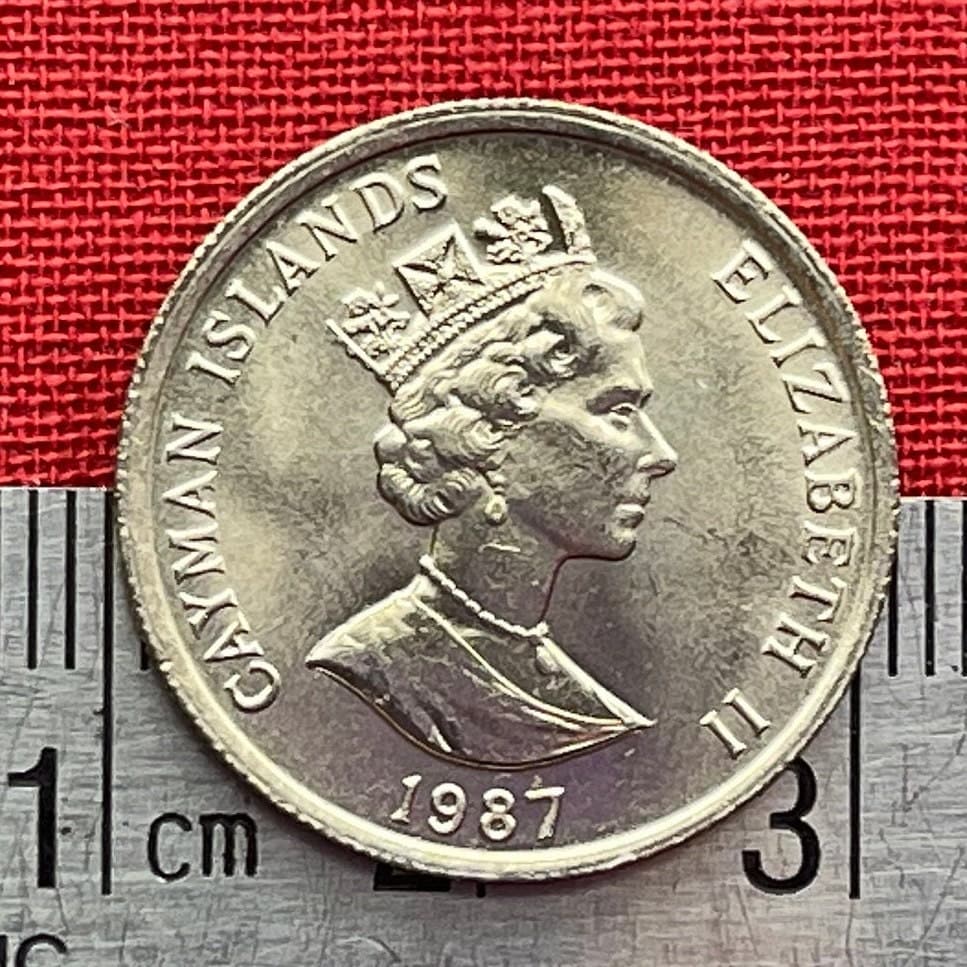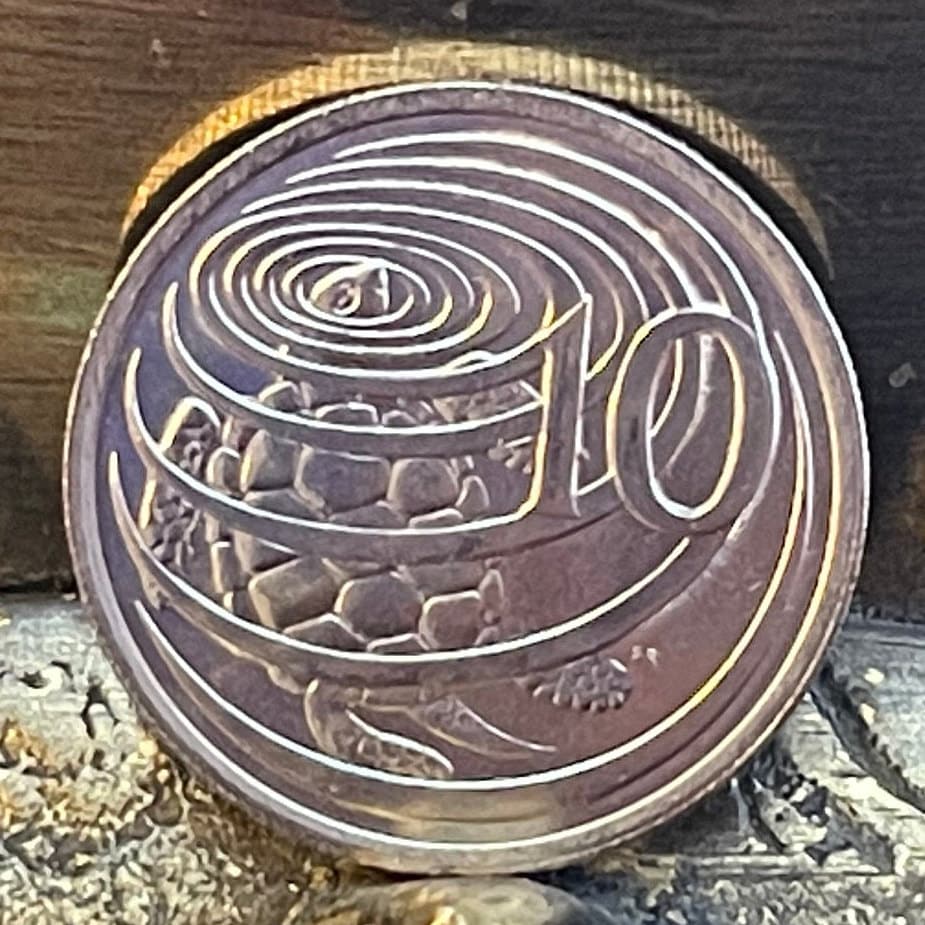elemintalshop
Sea Turtle Surfacing 10 Cents Cayman Islands Authentic Coin Money for Jewelry and Craft Making (Las Tortugas) (Green Sea Turtle)
Sea Turtle Surfacing 10 Cents Cayman Islands Authentic Coin Money for Jewelry and Craft Making (Las Tortugas) (Green Sea Turtle)
Couldn't load pickup availability
Green Sea Turtle 10 Cents Cayman Islands Authentic Coin Money for Jewelry and Craft Making (Las Tortugas)
Reverse: Green Sea Turtle surfacing creating ripples, denomination to the right.
Lettering: 10
Obverse: Crowned bust right, surrounded by legend, date below
Lettering: CAYMAN ISLANDS ELIZABETH II
Features
Issuer Cayman Islands
Queen Elizabeth II (1952-date)
Type Standard circulation coin
Years 1987-1990
Value 10 Cents
0.1 KYD = USD 0.12
Currency Dollar (1972-date)
Composition Copper-nickel
Weight 3.9 g
Diameter 21 mm
Thickness 1.45 mm
Shape Round
Technique Milled
Orientation Medal alignment ↑↑
Number N# 5412
References KM# 89
Wikipedia:
Sea turtles are integral to the history and culture of the Cayman Islands. When the islands were first discovered by Christopher Columbus in 1503, he named them "Las Tortugas" because of the abundance of sea turtles in the waters around the islands. Many of the earliest visitors came to the Cayman Islands to capture the turtles as a source of fresh meat during long voyages. The green turtle is a national symbol displayed as part of the coat of arms of the Cayman Islands, which also forms part of the national flag of the Cayman Islands. The country's currency uses a turtle as the watermark in its banknotes. A stylised sea turtle nicknamed "Sir Turtle" is the mascot of the national airline Cayman Airways and is part of the livery of its aircraft.
********
The green sea turtle (Chelonia mydas), also known as the green turtle, black (sea) turtle or Pacific green turtle, is a species of large sea turtle of the family Cheloniidae. It is the only species in the genus Chelonia. Its range extends throughout tropical and subtropical seas around the world, with two distinct populations in the Atlantic and Pacific Oceans, but it is also found in the Indian Ocean. The common name refers to the usually green fat found beneath its carapace, not to the color of its carapace, which is olive to black.
The dorsoventrally flattened body of C. mydas is covered by a large, teardrop-shaped carapace; it has a pair of large, paddle-like flippers. It is usually lightly colored, although in the eastern Pacific populations, parts of the carapace can be almost black. Unlike other members of its family, such as the hawksbill sea turtle, C. mydas is mostly herbivorous. The adults usually inhabit shallow lagoons, feeding mostly on various species of seagrasses. The turtles bite off the tips of the blades of seagrass, which keeps the grass healthy.
Like other sea turtles, green sea turtles migrate long distances between feeding grounds and hatching beaches. Many islands worldwide are known as Turtle Island due to green sea turtles nesting on their beaches. Females crawl out on beaches, dig nests, and lay eggs during the night. Later, hatchlings emerge, and scramble into the water. Those that reach maturity may live to 80 years in the wild.
C. mydas is listed as endangered by the IUCN and CITES and is protected from exploitation in most countries. It is illegal to collect, harm, or kill them. In addition, many countries have laws and ordinances to protect nesting areas. However, turtles are still in danger due to human activity. In some countries, turtles and their eggs are still hunted for food. Pollution indirectly harms turtles at both population and individual scales. Many turtles die after being caught in fishing nets. In addition, real estate development often causes habitat loss by eliminating nesting beaches.
Importance to humans
Historically, the turtles' skin was tanned and used to make handbags, especially in Hawaii. Ancient Chinese considered the flesh of sea turtles a culinary delicacy, including and especially C. mydas. Particularly for this species, the turtle's fat, cartilage, and flesh, known as calipee, are sought as ingredients for making turtle soup, a popular 19th-century American dish.
In Java, Indonesia, sea turtle eggs were a popular delicacy. However, the turtle's flesh is regarded as ḥarām or "unclean" under Islamic law (Islam is Java's primary religion). In Bali, turtle meat was a prominent feature at ceremonial and religious feasts. Turtles were harvested in the remotest parts of the Indonesian archipelago. Bali has been importing sea turtles since the 1950s, as its own turtle supplies became depleted. The mostly Hindu Balinese do not eat the eggs, but sell them instead to local Muslims.
Commercial farms, such as the Cayman Turtle Farm in the West Indies, once bred them for commercial sale of turtle meat, turtle oil (rendered from the fat), turtle shell, and turtle leather made from the skin. The farm's initial stock was in large part from "doomed" eggs removed from nests threatened by erosion, flooding, or in chemically hostile soil. The farms held as many as 100,000 turtles at any one time. When the international markets were closed by regulations that did not allow even farm-bred turtle products to be exported internationally, the surviving farm became primarily a tourist attraction, supporting 11,000 turtles. Initially started as Mariculture Ltd., then Cayman Turtle Farm Ltd and subsequently branded Boatswain's Beach, in 2010 the farm's brandname was changed to Cayman Turtle Farm: Island Wildlife Encounter.
.....
A ki'i pōhaku (petroglyph) of a turtle (or honu) can be found on The Big Island of Hawaii in the Pu'u Loa lava fields. The green sea turtle (called Honu) has always held a special meaning for Hawaiians and this petroglyph shows its importance dating to possibly when the islands first became populated. The turtle symbolizes a navigator that can find his way home time after time. This symbol mirrors the real life of the green Hawaiian turtle as it will swim hundreds of miles to lay its eggs at its own place of birth. Though there are other myths as well, some Hawaiian legends say the honu were the first to guide the Polynesians to the Hawaiian Islands. Hawaiians revere the turtle and the legend of Kailua, a turtle who could take the form of a girl at will. In human form, she looked after the children playing on Punalu'u beach.
Share










Great coin, I will order again. Thanks, Christopher Speer
Very nice coin, thank you!
Smooth, quick transaction, highly recommend this buyer
Excellent quality and fast shipping! I adore this shop.
5 stars review from Crystal









